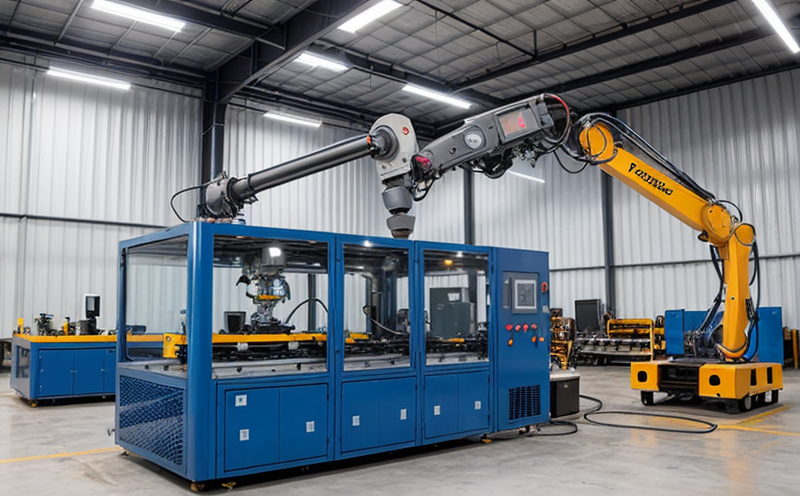ISO 18653 Positioning Accuracy Testing of Industrial Robots
The ISO 18653 standard provides a structured approach to testing and evaluating the positioning accuracy of industrial robots. This service ensures that robotic systems meet the required precision levels for their intended applications in manufacturing, processing, and automation sectors.
Positioning accuracy is critical in industries where high precision is essential, such as electronics assembly, pharmaceuticals, aerospace, automotive, and food and beverage production. The ISO 18653 standard defines the methodology to assess positioning repeatability, reproducibility, and absolute accuracy of industrial robots.
The testing process involves several key steps. First, the robot is calibrated using a known reference point. Then, it performs a series of predefined movements in multiple axes. The deviations from the expected positions are measured and recorded. This data is analyzed to determine the positioning accuracy according to ISO 18653 criteria.
The standard also includes guidelines for selecting appropriate test fixtures and sensors to ensure accurate measurement. Proper specimen preparation, including cleaning and aligning the robot with the reference point, is crucial before testing. Calibration of all instruments used in the process ensures that measurements are consistent and reliable.
Once testing is complete, a detailed report is generated, outlining the positioning accuracy results against ISO 18653 specifications. This report serves as a valuable tool for quality managers and compliance officers to ensure their industrial robots meet industry standards. For R&D engineers, this service provides critical insights into improving robotic systems' performance.
The testing process adheres strictly to international standards such as ISO 18653:2019, which ensures consistent and reliable results across different laboratories. Compliance officers can use these test results to demonstrate adherence to regulatory requirements.
Industrial robotics are becoming increasingly complex, with multi-axis motion, advanced sensors, and sophisticated control systems. The ISO 18653 standard helps ensure that these robots operate within specified tolerances, enhancing productivity and reducing errors in manufacturing processes.
In summary, ISO 18653 positioning accuracy testing is essential for maintaining high standards of precision in industrial robotics. This service ensures that robotic systems perform as expected, contributing to the overall quality and reliability of products across various industries.
Eurolab Advantages
At Eurolab, we pride ourselves on providing comprehensive testing services tailored to meet the unique needs of our clients. Our ISO 18653 positioning accuracy testing service offers several advantages:
- Accurate and Reliable Results: We use state-of-the-art equipment calibrated according to international standards.
- Comprehensive Reporting: Detailed reports provide a clear understanding of the robot's performance against ISO 18653 criteria.
- Expertise and Experience: Our team comprises highly skilled professionals with extensive experience in robotics testing.
- Customized Solutions: We offer tailored solutions to meet specific client requirements, ensuring optimal test conditions.
- Timely Delivery: Our efficient processes ensure that results are delivered on time, minimizing downtime for clients.
- Compliance Assurance: Testing ensures compliance with international standards, reducing the risk of non-conformity issues.
By choosing Eurolab for your ISO 18653 positioning accuracy testing needs, you can be confident in the quality and reliability of our services. Our commitment to excellence and client satisfaction is unmatched in the industry.
Environmental and Sustainability Contributions
The precision engineering and manufacturing sectors contribute significantly to environmental sustainability by reducing waste, improving efficiency, and minimizing resource consumption. ISO 18653 positioning accuracy testing plays a crucial role in ensuring that industrial robots operate efficiently and accurately, thereby enhancing productivity and reducing energy consumption.
By adhering to the standards outlined in ISO 18653, manufacturers can optimize their robotic systems, leading to reduced production errors and reworks. This not only improves product quality but also contributes to a more sustainable manufacturing process by minimizing material waste and resource usage.
The accurate positioning of industrial robots is essential for automating complex processes that require high precision. By ensuring that these robots operate within specified tolerances, ISO 18653 testing helps reduce overproduction and optimize production schedules, contributing to energy savings and reduced carbon footprint.
Additionally, the precise control provided by ISO 18653-compliant systems can enable manufacturers to adopt leaner production methods, further reducing waste and improving overall efficiency. This focus on sustainability aligns with global efforts to promote environmentally friendly practices in manufacturing and processing industries.
In conclusion, ISO 18653 positioning accuracy testing is not only critical for maintaining high standards of precision but also for contributing to a more sustainable future in industrial robotics and automation.
Use Cases and Application Examples
| Use Case | Description |
|---|---|
| Electronics Assembly | Ensuring precise placement of components to meet quality standards. |
| Aerospace Manufacturing | Guaranteeing accurate part positioning for complex assemblies. |
| Pharmaceutical Production | Maintaining consistent product quality through precise robotic movements. |
| Automotive Assembly | Accurate placement of parts to ensure safe and reliable vehicle production. |
| Food and Beverage Processing | Ensuring proper packaging and labeling for food safety compliance. |
| Metalworking | Precise cutting and shaping of metal components. |
| Plastic Manufacturing | Consistent molding and forming processes to meet product specifications. |
| Medical Device Manufacturing | Accurate positioning for critical medical component assembly. |
The application of ISO 18653 positioning accuracy testing extends across various sectors, ensuring that industrial robots perform their tasks with precision and reliability. This table highlights some of the key use cases where this service is particularly beneficial.





